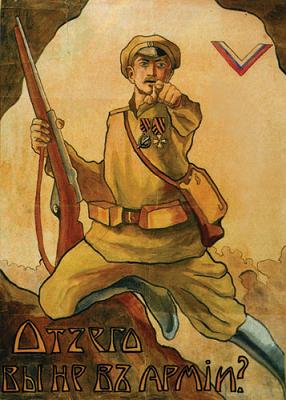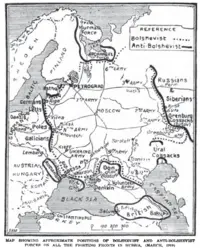Difference between revisions of "The Volunteer Army" - New World Encyclopedia
(credit Wiki) |
|||
| Line 1: | Line 1: | ||
| + | {{Claimed}} | ||
{{Distinguish|Volunteer military}} | {{Distinguish|Volunteer military}} | ||
Revision as of 15:13, 2 October 2007
- Not to be confused with Volunteer military.
The Volunteer Army (Добровольческая армия in Russian, or Dobrovolcheskaya armiya) was a counterrevolutionary army in South Russia during the Russian Civil War of 1918-1920.
The Volunteer Army began forming in November-December of 1917 by General Mikhail Alekseev in Novocherkassk and General Lavr Kornilov and his supporters. Initially, the Volunteer Army included volunteering officers, cadets, students and Cossacks. On December 27, 1917 (January 9, 1918), the creation of the Volunteer Army was officially announced. Alekseev became its overall leader, Kornilov - its Commander-in-chief, General Alexander Lukomsky - its Chief of Staff, General Anton Denikin – commander of the 1st Division and General Sergey Markov – commander of 1st Officers regiment. They also created the so called Special Council at the headquarters, which included also included prominent civilian politicians such as Peter Struve, Pavel Milyukov, Mikhail Rodzianko, Sergey Sazonov and Boris Savinkov.
In early January 1918, the Volunteer Army numbered approximately 4,000 men and fought against the Red Army together with the units of General Aleksei Kaledin. In late February, the Volunteer Army had to retreat from Rostov-on-Don due to the onset of the Red Army and left for Kuban in order to unite with the Kuban Cossack formations, a manoeuvre known as the Ice March. However, most of the Kuban Cossacks did not give their support to the Volunteer Army. Only a small unit (3,000 men) under the command of General Viktor Pokrovsky joined the Volunteer Army on March 26, 1918, increasing its number to 6,000 people. The Volunteer Army's attempt to capture Yekaterinodar between April 9 and April 13 was a fiasco, costing Kornilov his life. General Denikin took the command over the remnants of the Volunteer Army and left for the remote stanitsas beyond the Don region. In June 1918, 3,000 men of Colonel Mikhail Drozdovsky joined the Volunteer Army. On June 23, the Volunteer Army (8,000-9,000 men) began its so called Second Kuban Campaign with the support from Pyotr Krasnov. By September 1918, the Volunteer Army had already had 30,000-35,000 men thanks to mobilization of the Kuban Cossacks and "counterrevolutionary elements", gathered in the North Caucasus. Thus, the Volunteer Army took the name of the Caucasus Volunteer Army.
In the Autumn of 1918, the governments of Great Britain, France and the USA increased their material and technical assistance to the Volunteer Army. With the support from Entente, the forces of the South Russian Whites were combined into the so called Armed Forces of South Russia (Вооружённые силы Юга России, or Vooruzhenniye sily Yuga Rossii) under the command of Denikin. In the late 1918 - early 1919, Denikin managed to inflict a defeat on the 11th Soviet Army and capture the North Caucasus region. In January of 1919, the Caucasus Volunteer Army was divided into the Caucasus Army and the Volunteer Army, which would later be joined by the Don Army, created from the remnants of Krasnov's Cossack army. After capturing Donbass, Tsaritsyn and Kharkov in June 1919, Denikin began to advance towards Moscow on June 20 (July 3). According to his plan, the main blow to Moscow was to be inflicted by the Volunteer Army (40,000 men) under the command of General Vladimir May-Mayevsky.
The White Army was accused by the Soviets of cruelty in its conquered territories, usually against the workers, for which the Soviet historiography would dub this regime "Denikinschina". Some of the units and formations of the Volunteer Army possessed good military skills and fighting strength due to a large number of officers in its ranks, who hated and despised the Soviets. However, the Volunteer Army's fighting efficiency started to decrease in the summer of 1919 in light of significant losses and conscription of mobilized peasants and even Red Army soldiers in captivity.
During the counter-offensive of the Red Army (since October 1919), the Volunteer Army sustained a decisive defeat and rolled back to the South. In the early 1920, it retreated to the areas beyond the Don region and was reduced to a Corps of 5,000 men under the command of General Alexander Kutepov.
On March 26 and March 27, 1920, the remnants of the Volunteer Army were evacuated from Novorossiysk to the Crimea, where they merged with the army of Pyotr Wrangel.
See also
- White movement
- West Russian Volunteer Army
- Russian Civil War
- Russian Liberation Movement
- Russian Liberation Army
- Russian Corps
- Allied Intervention in the Russian Civil War
External links
it:Armata dei Volontari nl:Vrijwilligersleger pl:Armia Ochotnicza ro:Armata Voluntarilor ru:Добровольческая армия
Credits
New World Encyclopedia writers and editors rewrote and completed the Wikipedia article in accordance with New World Encyclopedia standards. This article abides by terms of the Creative Commons CC-by-sa 3.0 License (CC-by-sa), which may be used and disseminated with proper attribution. Credit is due under the terms of this license that can reference both the New World Encyclopedia contributors and the selfless volunteer contributors of the Wikimedia Foundation. To cite this article click here for a list of acceptable citing formats.The history of earlier contributions by wikipedians is accessible to researchers here:
The history of this article since it was imported to New World Encyclopedia:
Note: Some restrictions may apply to use of individual images which are separately licensed.

